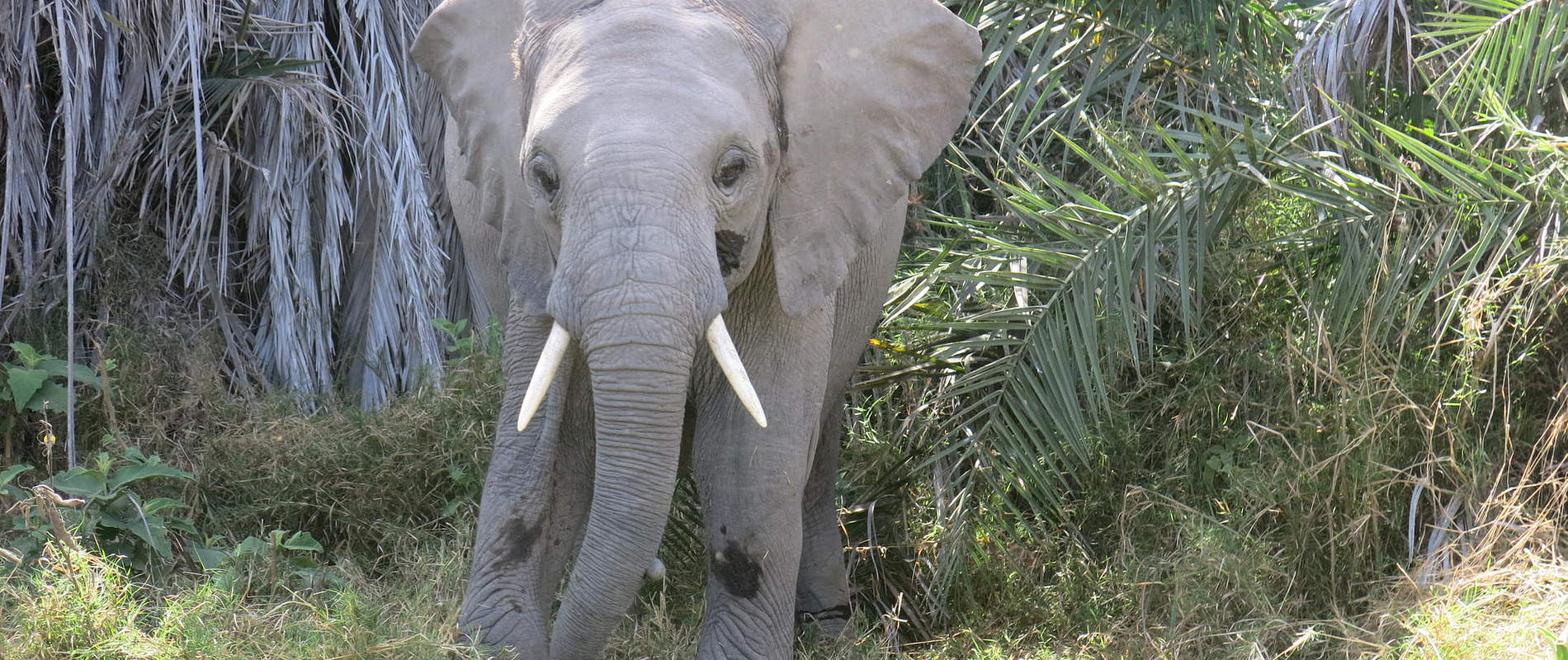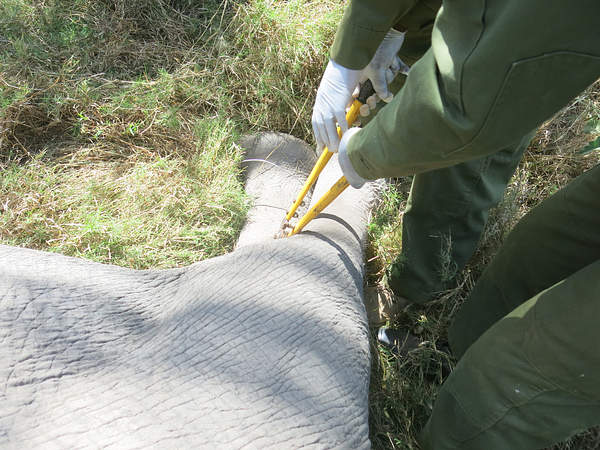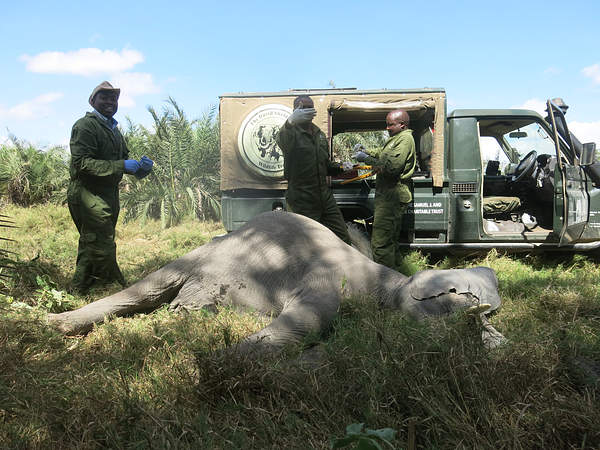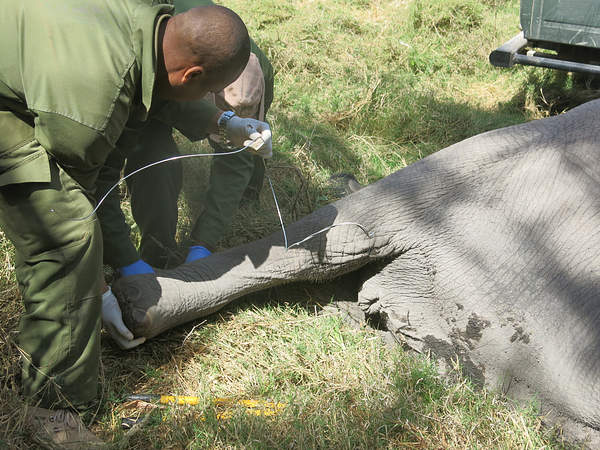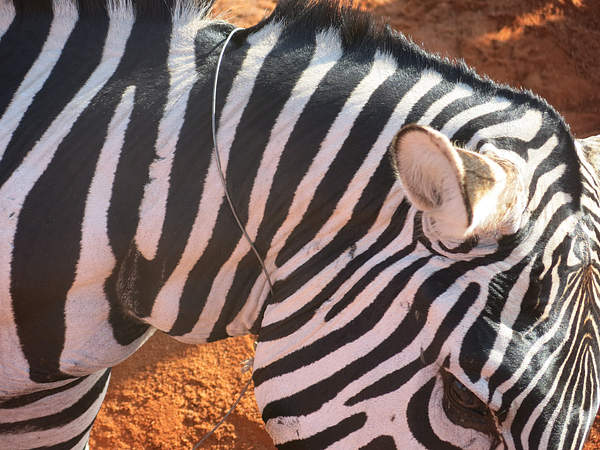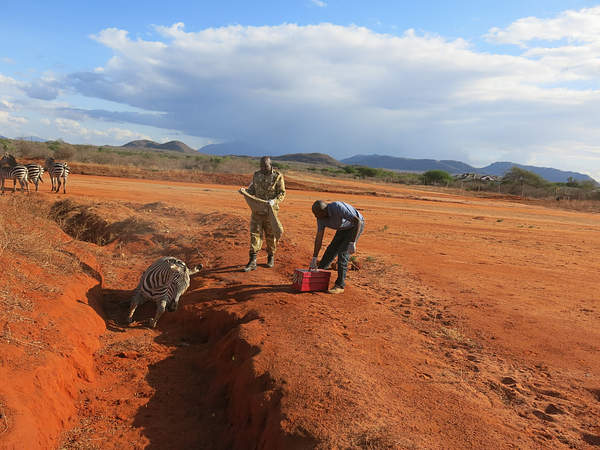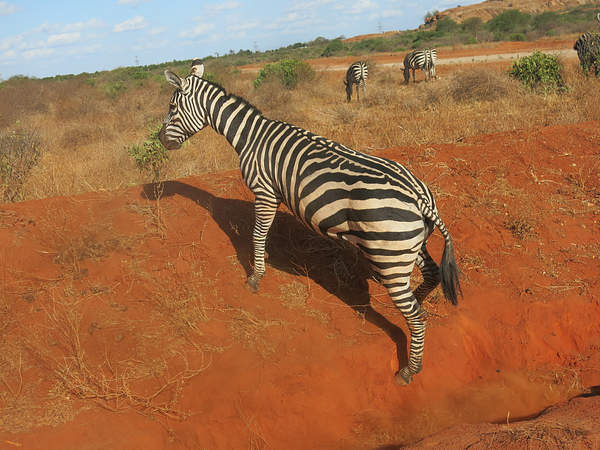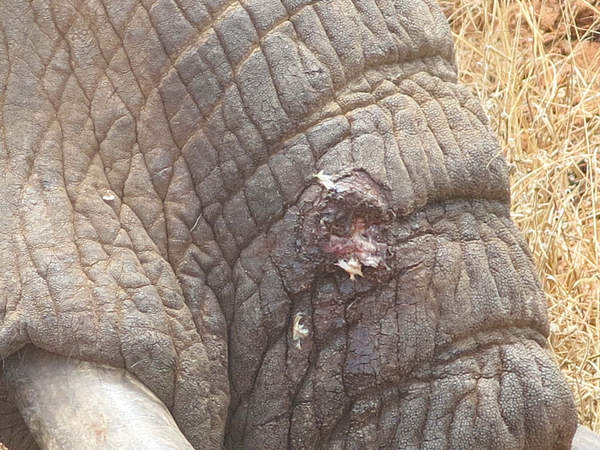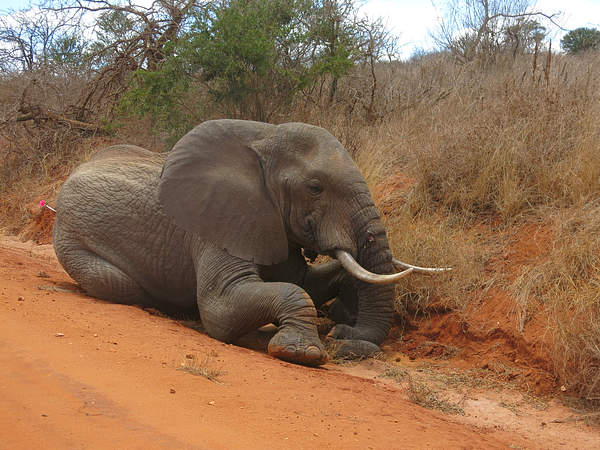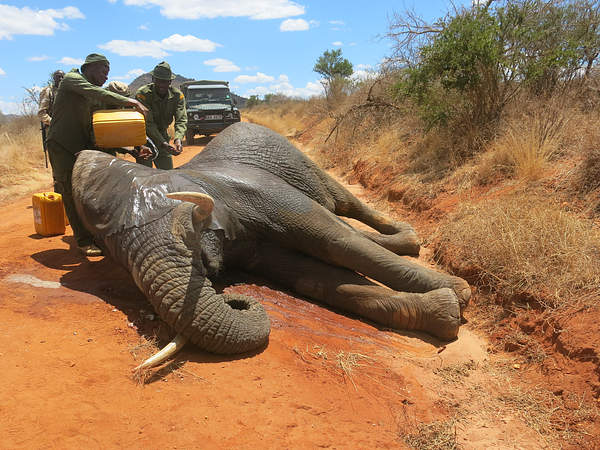Sixteen wildlife cases were reported and attended to by the Amboseli Mobile Veterinary Unit during the month of September 2018. Six received therapeutic treatment while two (an elephant calf and hyena) were postmortem examination.
Its the observation of the Unit that any carcass that took 24 hours to be examined was always scavenged. This is due to the stable and vicious population of hyenas and vultures in the park. Additionally, the park provides for quick visibility of the carcasses due to the low height of the natural grassland and the few shrubs available. Six elephants were considered for further monitoring while a giraffe and a zebra could not be treated due to the thick bush in which they were found. Attempts to drive the giraffe out for treatment took 2 vehicles and an aircraft 4 hours with no success.
CASE#1 TREATMENT OF A SNARED ELEPHANT
Date: 8 September 2018.
Species: African Elephant (Loxodonta Africana)
Age: 5 years old (sub-adult)
Sex: Male
Location: Amboseli National Park


History: The Veterinary Unit received a report from Ol-Tukai Lodge and the Amboseli Trust for Elephants of an elephant with a wire on the left hind leg. The first report was received on the 7th of September by the Amboseli Trust for Elephants, whilst the second report was received from staff at the Ol-Tukai Lodge on the 8th of September.
Immobilization, examination and treatment: Researchers at the Amboseli Trust for Elephants followed and traced the herd through the palm bushes in order to ensure treatment. The young elephant was located and darted from a vehicle. Chemical restraint was attained using Etorphine Hcl (total dose 14mgs). The elephant reached recumbent anesthesia 10 minutes after darting. He was rested on lateral recumbency to facilitate wire removal and prevent respiratory complications.
A second vehicle chased away the herd in order to ensure the safety of the Vet Team during the treatment of the young male. The wire was loose and had caused no damage to the leg. The wire was easily removed by cutting it off with wire cutters, and 50ml of Amoxicillin (Betamox LA®) was administered to prevent secondary infection through the darting wound.
Reversal and prognosis: Anaesthesia was reversed intravenously using Diprenorphine. Prognosis for full recovery was good as there were no complications due to the wire.
CASE#2 TREATMENT OF A LAME ZEBRA
Date: 13 September 2018.
Species: Common Zebra (Equus gauga)
Age: Adult
Sex: Female
Location: Amboseli National Park
History: Noah, a KWS driver, sighted and reported the lame zebra whilst on patrol.
Immobilization, examination and treatment: The zebra was located and darted from a vehicle. A cocktail of 4mg Etorphine Hcl and 60 mg Azaperone was used to immobilize the zebra. Successful immobilization and lateral recumbency was attained 7 minutes after darting. The left fore leg was dislocated as felt by palpation and joint movement. Flunixin meglumin and Betamox LA®, Amoxicillin was administered to prevent pain and infection due to the fracture.

Reversal and prognosis: The aneasthesia was reversed using 2ml of Diprenorphine, which was adeministered intravenously. Prognosis for full recovery is fair since the animal could be easy prey for lions and hyenas.
CASE#3 TREATMENT OF A ZEBRA WITH FORE LEG FRACTURE
Date: 23 September 2018.
Species: Common Zebra (Equus gauga)
Age: Adult
Sex: Female
Location: Osoit, Namelok area
History: Big Life Rangers reported an injured zebra to the Amboseli Veterinary Unit on the 23rd of September 2018. The zebra was located at a rocky area referred to as Osoit (the local vernacular name for rocks) in Namelok. The injuries on the zebra followed a severe territorial fight between two males.

Immobilization, examination and treatment: The zebra was found lying down and not willing to move away even once in sight of people. However, it had to be chemicaly restrained to prevent struggling during examination. The zebra was darted on foot. A cocktail of 4mg Etorphine Hcl and 60 mg Azaperone immobilized the male to attain complete restraint 5 minutes after darting. The stallion rested on lateral recumbency during the examination. The right foreleg was completely fractured while the body had multiple deep bite wounds.
Prognosis: The prognosis was poor since the zebra could not walk and lay down in pain. 15ml of Pentobarbitone 20% (Etha-naze®) euthanized the animal to stop the adverse suffering.
CASE#4 TREATMENT OF A SNARED ZEBRA
Date: 25 September 2018.
Species: Zebra (Equus gauga)
Age: Adult
Sex: Female
Location: Manyani Law Enforcement Academy
History: The Vet Team received a report of a common zebra with a snare wire round the neck on the 25th of September 2018. The zebra was found grazing at the periphery of Manyani Airstrip in a group of five other zebras.
Immobilization, examination and treatment: The zebra was located and darted from a vehicle. Etorphine Hcl (total dose 5mg) and 60mg Azaperone were used to immobilize the female zebra. Successful restraint and lateral recumbency was attained 8 minutes after darting. The snare wire was loose and easy to remove. The wire snare was one that is normally used for in poaching attempts. Betamox LA®, Amoxicillin was administered to prevent secondary bacterial infection via the darting wound.
Reversal and prognosis: Diprenorphine was used to reverse the aneasthsia. Prognosis for full recovery is good since the wire had not inflicted any injury nor was there any complication.
Our Mobile Vet Units are in the field every day saving wild lives
CASE#5 TREATMENT OF INJURED ELEPHANT
Date: 26 September 2018.
Species: Elephant, Loxodonta africana
Age: Adult
Sex: Male
Location: Tsavo West National Park
History: The DSWT Mobile Vet Team reported and attended to an elephant bull in Tsavo West, with a wound on his trunk, on the 26th of September 2018.
Immobilization, examination and treatment: The elephant was located and darted from a chopper. Etorphine Hcl (total dose of 20 mg) was used to immobilize the male elephant. Full restraint was attained 12 minutes after darting. The bull fell on sternal recumbency and had to be pulled down with ropes to lateral recumbency.
A deep wound was observed, penetrating into the upper part of the trunk. The wound was so deep that two foot long forceps could go through. The wound depth runs in a direction and that could help explain a probable tusk injury after a bullfight. The bull was administered 100ml Amoxicillin (Betamox LA®) to prevent bacterial infection. Green clay paste was injected into the wound to facilitate healing and prevent infection.

Reversal and prognosis: Aneasthesia was reversed using Diprenorphine. Prognosis for full recovery is good.
CASE#6 TREATMENT OF LAME BLACK RHINO
Date: 28 September 2018.
Species: Black rhino, diceros michaeli
Age: adult
Sex: Male
Location: Ngulia, sanctuary, Tsavo West National Park
History: A lame rhino was reported by KWS Rangers after the case was noted during the Night Rhino Night census.
Immobilization, examination and treatment: The rhino was located and darted from a chopper. A cocktail of 4mg Etorphine Hcl and 70 mg Azaperone was used to immobilize the male. The drug was delivered using a projectile dart and the animal was successfully restrained 10 minutes after darting. The rhino was examined whilst on sternal recumbency.

Upon physical examination it was found that the rhino had an old healed injury. The old injury healed with a deformity that led to abnormal posture while walking. The rhino was in good body condition and had no other complications due to the injury apart from the abnormal walking posture. Betamox LA®, Amoxicillin was administered to prevent secondary infections.
Reversal and prognosis: Butorphanol (10mg) was used to stabilize anaesthesia, while Diprenorphine (12mg) was used to reverse aneasthesia.
CASE#7 POST MORTEM EXAMINATION OF AN ELEPHANT CALF
Date: 29 September 2018.
Species: African elephant (Loxodonta africana)
Age: 5 months calf
Sex: Female
Location: Amboseli National Park
History: The female elephant calf was born of a twin with a male calf. The calf died on the 28th of September 2018 at about 3.30 pm. The mother (Paru) and the twin male are healthy and well.
Examination and findings: The carcass was scavenged by hyenas and vultures during the night, before the 29th of September 2018 when the postmortem was done. The carcass remains were not enough to conduct a full pathological examination and analysis. However, the skeleton was good enough to demonstrate that the backline wound was not beyond the skin

Cause of death: Unclear and deficient. However, the amount of milk a lactating female can produce, current feed availability and the aggressive feeding behavior of the twin male, could assist in explaining the natural rarity and low survival of such births.
OTHER OBSERVATIONS
An elephant calf reported to be dragging one foot, had an old injury that completely affected the joints. The old injury healed with a swelling that reduced joint mobility. The elephant was healthy and had no wound or any visible foreign material, like a snare. The elephant was not desperate for treatment and was acquitted the stress of darting.
Four elephants were reported with wobbling walking gait. One calf was almost unable to move. Among the four cases, the calves were more affected than the adults. Monitoring was prescribed after a history of such periodical cases was observed by the Amboseli Trust for Elephants.
A dead hyena requiring a postmortem examination was reported by the KWS Patrol Team. The carcass was old and eviscerated thereby lacking enough material for a comprehensive pathological examination.
An elephant (named Jackson) was reported with a sagging abdominal swelling. The swelling later to be determined as a hernia is complicated for a surgical intervention which is the ideal treatment. Jackson’s normal feeding area is in the marshy pools and a surgical wound is prone to an immeasurable challenge of secondary bacterial infection. The elephant is under monitoring for future intervention in case of health deterioration. So far the elephant has dealt with and adapted to living with the condition. Jackson is about 35 years old.
A giraffe and a grevy zebra at Rukinga Ranch could not be traced for darting and treatment. However, monitoring is ongoing for treatment in the future.
Acknowledgment
Report by KWS Vet Dr Edward Kariuki. We thank the David Sheldrick Wildlife Trust (DSWT) for material support and Mobile Unit funding, KWS for logistical support and security. The Amboseli Trust for Elephants, Kitirua Wildlife Trust, Wildlife Works and Big Life Ndovu TZ for reporting and monitoring of distressed wild animals. We are always indebted, thank you for your kind support in the conservation of wildlife in Kenya.
